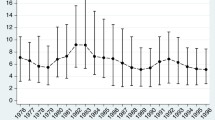Abstract
This is an empirical study of early postenrollment wage determinants of white young men in the 1966 to 1971 period. Data are from the National Longitudinal Survey for young men. The focus is on student labor force status as a determinant of postenrollment wage rates. As such, the results are related to the combined employment and college enrollment goal expressed repeatedly in federal work-study programs from the 1930s to date. Results suggest that work while enrolled may not only support the student, but mitigate transition problems to full-time work after enrollment. The major result, found with OLS multiple regression techniques, is that student job holding significantly and positively increased postenrollment wage rates relative to youth who neither worked nor looked for work as students. This indirect effect implies that the social cost of the college work-study program may be less than the federal outlays if the extra work experience enables a youth to obtain a more productive and higher paying job after enrollment.
Similar content being viewed by others
References
Goldberger, A. S.Econometric theory. New York: John Wiley & Sons, 1964.
Griliches, Z. The wages of very young men.Journal of Political Economy, 1976.84(pt. 2), 569–586.
Heyneman, S. R., and Daniels, W. Adolescence research and national youth policy: what we know and what we don't know. Prepared for USDHEW/ASPE under contract no. 105-76-1120, Fall 1976.
Lazear, E. Age, experience, and wage growth.American Economic Review, September 1976, 66(4), 548–558.
Meyer, R. H., and Wise, D. A. High school preparation and early work experience. Unpublished manuscript prepared under U.S. Department of Labor contract J-9-M-8-0043 to National Bureau of Economic Research, April 1979.
Parnes, H. A., and Kohen, A. I. Occupational information and labor market status: the case of young men.Journal of Human Resources 1978 (Winter),10 44–55.
Policy options for the teenage unemployment problem (Background paper no. 13. Congressional Budget Office). Washington, D.C.: U.S. Government Printing Office. September 21, 1976.
Rosen, S. Human capital: a survey of empirical researcy. In R. Ehrenberg (Ed.),Research in labor economics (Vol. 1). Greenwich, CT: JAI Press, 1977, pp 355–374.
Stephenson, S. P., Jr. In-school labor force status and post-school wage rates of young men.Applied Economics (in press).
Stevenson, W. The relationship between early work experience and future employability. InThe lingering crisis of youth unemployment. Kalamazoo, Mich.: W. E. Upjohn Institute for Employment Research, 1979, pp 93–116.
The teenage unemployment problem: What are the options? (Congressional Budget Office). Washington, D.C.: U.S. Government Printing Office, October 1976.
Author information
Authors and Affiliations
Rights and permissions
About this article
Cite this article
Stephenson, S.P. Work in college and subsequent wage rates. Res High Educ 17, 165–178 (1982). https://doi.org/10.1007/BF00973717
Received:
Issue Date:
DOI: https://doi.org/10.1007/BF00973717




